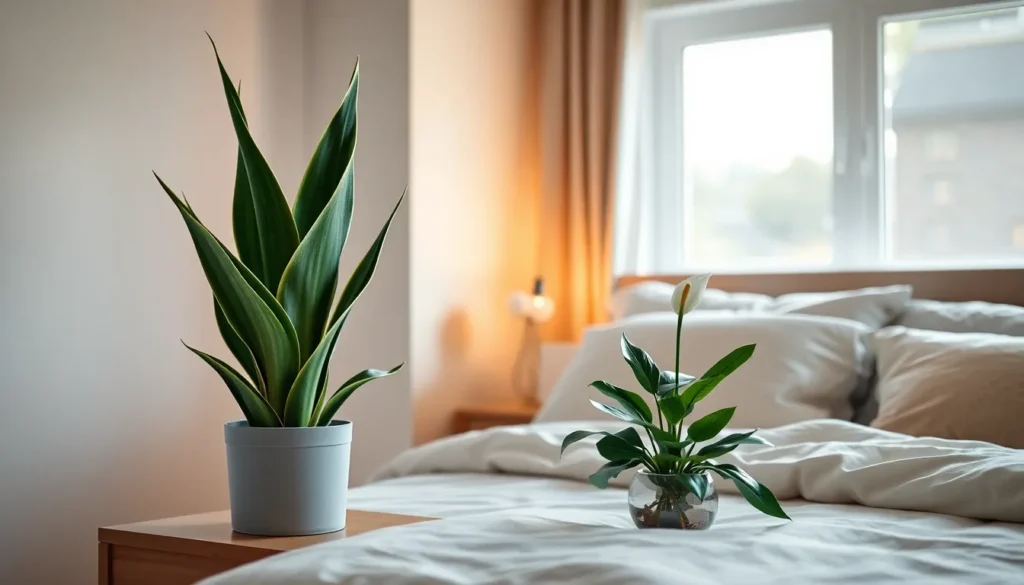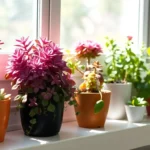We all crave a peaceful sanctuary where we can unwind after long days and enjoy restorative sleep. What if we told you that transforming your bedroom into a green oasis could dramatically improve your sleep quality while purifying the air you breathe every night?
Adding the right plants to your bedroom isn’t just about aesthetics – it’s about creating a healthier sleep environment. The best bedroom plants work tirelessly while you rest, removing harmful toxins from the air and releasing fresh oxygen. Some even produce moisture that can help you breathe easier during dry winter months.
We’ve researched the most effective bedroom plants that thrive in low-light conditions and won’t disrupt your sleep cycle. These green companions will help you wake up feeling more refreshed while adding natural beauty to your personal retreat.
Snake Plant: The Ultimate Low-Maintenance Air Purifier
Snake plants stand out as the perfect bedroom companion for busy homeowners seeking natural air purification without the hassle. Their unique ability to produce oxygen during nighttime hours makes them exceptional among houseplants.
Releases Oxygen at Night for Better Sleep
Most plants release carbon dioxide at night, but snake plants work differently by continuing their oxygen production after dark. This rare characteristic comes from their CAM (Crassulacean Acid Metabolism) photosynthesis process, which allows them to open their stomata during cooler nighttime hours. Studies show that having oxygen-producing plants in bedrooms can improve sleep quality by maintaining better air circulation throughout the night.
We recommend placing one medium-sized snake plant per 100 square feet of bedroom space to maximize these oxygen benefits. The continuous oxygen release helps maintain optimal air quality while you sleep, potentially reducing morning grogginess and improving overall rest quality.
Thrives in Low Light and Requires Minimal Watering
Snake plants excel in the dim lighting conditions typical of most bedrooms, making them ideal for spaces with limited natural light. They can survive in light levels as low as 200 lux, which is significantly lower than most other houseplants require. This adaptability means you can place them in corners, beside dressers, or anywhere that suits your bedroom layout.
Watering requirements are equally forgiving, with snake plants needing water only every 2-3 weeks during growing season and even less frequently in winter. Their thick, succulent-like leaves store water efficiently, preventing the overwatering issues that plague many indoor gardeners. We suggest checking the soil moisture by inserting your finger 2 inches deep before watering.
Removes Harmful Toxins from Indoor Air
NASA’s Clean Air Study identified snake plants as effective removers of common household toxins including formaldehyde, xylene, toluene, and nitrogen oxides. These chemicals often accumulate in bedrooms from furniture, carpets, cleaning products, and building materials. Snake plants can filter these pollutants through their leaves and root system, processing them into harmless compounds.
Research indicates that snake plants can remove up to 87% of harmful toxins from indoor air within 24 hours. Their broad, upright leaves provide substantial surface area for air filtration, while their root system continues the purification process. This dual-action approach makes them particularly effective at creating cleaner breathing environments in enclosed bedroom spaces.
Peace Lily: The Elegant Humidity Booster
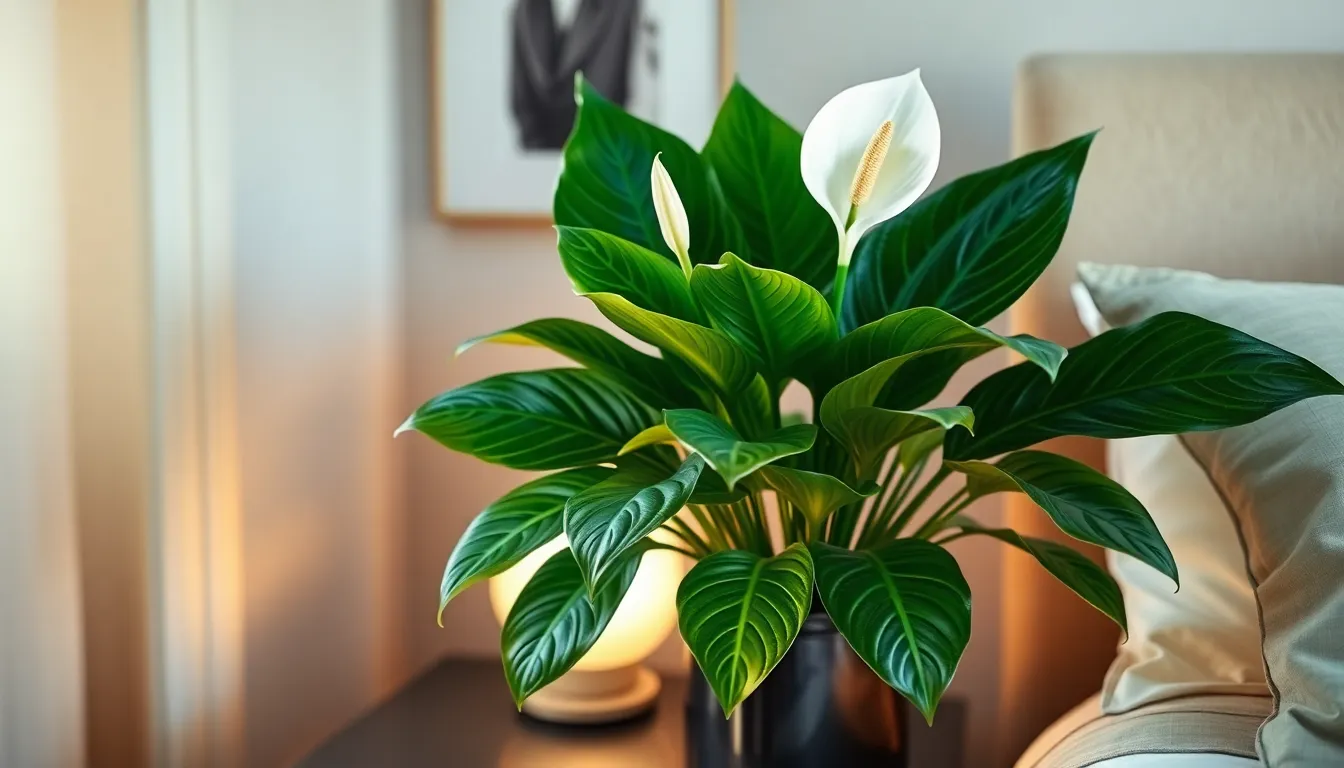
Peace lilies serve as natural humidifiers that complement the air purifying benefits we’ve discussed with snake plants. This elegant plant offers a perfect blend of functionality and beauty for bedroom environments.
Increases Moisture Levels for Comfortable Breathing
Peace lilies naturally boost humidity levels in your bedroom through their transpiration process. They release moisture into the air making breathing more comfortable during sleep especially in dry climates or winter months when indoor air tends to become stale. We recommend placing a peace lily near your bedside to create a localized zone of improved air moisture.
These plants work particularly well for people who wake up with dry throats or experience nighttime congestion. Your bedroom’s humidity levels can increase by 5-10% with a single mature peace lily which creates optimal conditions for restful sleep. The improved air moisture also benefits your skin and respiratory system throughout the night.
Features Beautiful White Blooms and Glossy Leaves
Peace lilies showcase stunning white flower spathes that emerge from dark green foliage creating an elegant contrast in bedroom decor. Their glossy leaves reflect ambient light beautifully making even dimly lit bedrooms appear more vibrant and alive. We find that their sophisticated appearance complements both modern and traditional bedroom styles.
The white blooms typically last 2-3 months before naturally fading while new flowers continue to emerge throughout the growing season. This continuous blooming cycle ensures your bedroom maintains its decorative appeal year round. Their compact growth habit makes them perfect for nightstands dresser tops or floor placement without overwhelming smaller spaces.
Filters Out Common Household Pollutants
Peace lilies excel at removing harmful toxins from indoor air including formaldehyde benzene and trichloroethylene commonly found in household items. NASA research identifies peace lilies as effective air purifiers that can significantly improve your bedroom’s air quality while you sleep. These plants actively absorb pollutants through their root system and leaves working continuously to create cleaner breathing environments.
We’ve found that a single peace lily can process toxins from a 100 square foot bedroom effectively. Their filtering capabilities work alongside increased humidity to create optimal air conditions for deep restorative sleep. The combination of toxin removal and moisture release makes peace lilies particularly valuable for bedrooms with poor ventilation or high pollutant levels from furniture and carpeting.
Aloe Vera: The Multi-Purpose Healing Plant
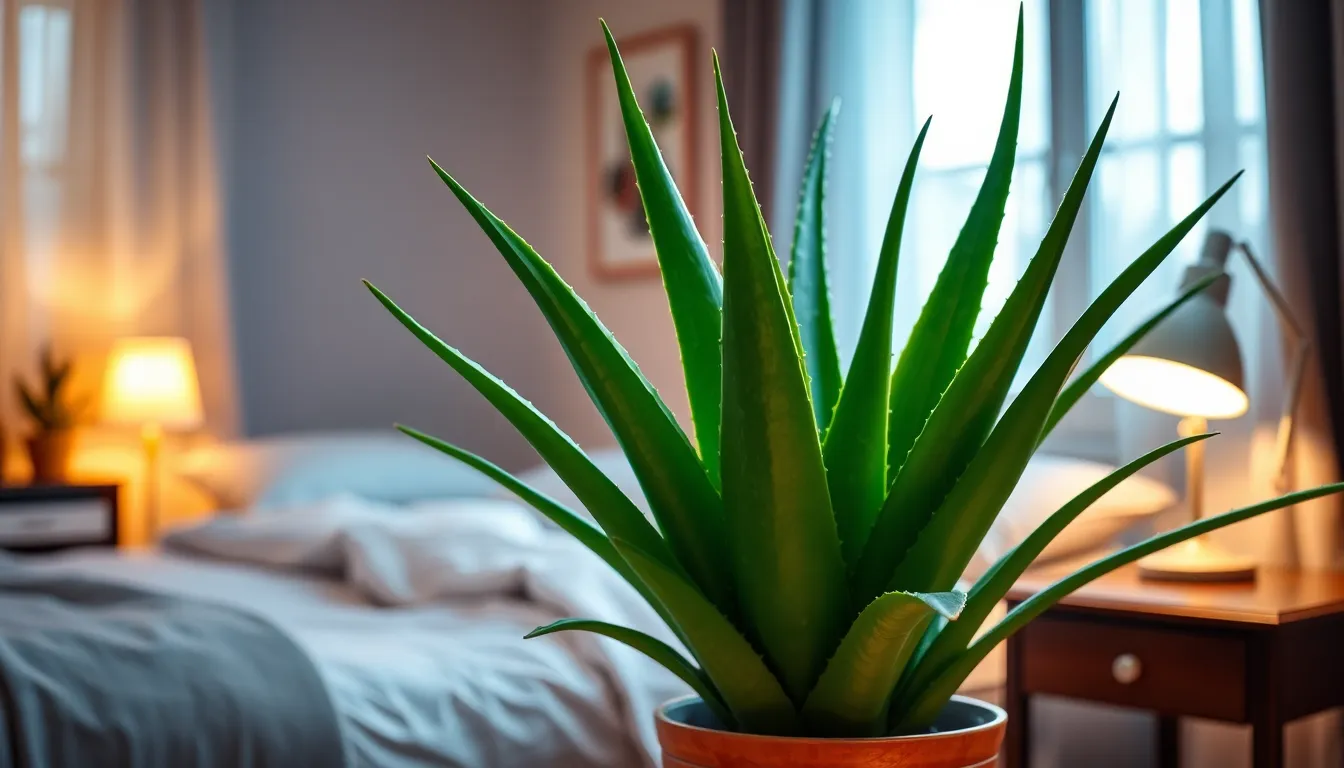
Aloe vera stands out as one of the most versatile bedroom plants we can choose for our sleeping spaces. This succulent powerhouse combines air purification, healing properties, and incredibly easy care requirements.
Provides Natural Air Purification Benefits
Aloe vera absorbs harmful chemicals commonly found in household products such as detergents, paints, and glues throughout the night. Unlike most plants that release carbon dioxide after dark, this remarkable succulent continues producing oxygen while we sleep. The plant’s unique ability to release oxygen during nighttime hours makes it an exceptional choice for bedroom air quality improvement.
Working continuously to filter indoor air pollutants, aloe vera creates a cleaner breathing environment that complements the benefits we get from snake plants and peace lilies. Its air purifying capabilities focus specifically on removing toxic compounds that accumulate from everyday household items. The plant’s thick, fleshy leaves store these filtered toxins safely away from our breathing space.
Offers Medicinal Properties for Skin Care
Aloe vera gel provides immediate relief for minor burns, cuts, and skin irritations right at our bedside. Having this natural remedy within arm’s reach eliminates late night trips to the medicine cabinet for common skin issues. The plant’s healing gel contains compounds that soothe inflammation and promote faster skin recovery.
Fresh aloe gel works more effectively than many commercial products because it retains all its natural healing properties. We can simply break off a small piece of leaf and apply the gel directly to affected skin areas. This immediate access to natural healing makes aloe vera particularly valuable for families with children who experience frequent minor scrapes and burns.
Requires Minimal Care and Infrequent Watering
Aloe vera thrives with minimal attention, requiring water only every 2-3 weeks depending on bedroom humidity levels. The plant’s succulent nature means it stores water in its thick leaves, making it virtually impossible to underwater. Overwatering poses the only real threat to aloe vera’s health, as soggy soil can quickly lead to root rot.
Bedroom lighting conditions rarely affect aloe vera’s growth since it tolerates low light environments exceptionally well. The plant actually prefers indirect sunlight, making it perfect for bedrooms with limited natural light exposure. Temperature fluctuations that might stress other houseplants don’t bother aloe vera, as it adapts easily to typical indoor climate variations.
Spider Plant: The Prolific Oxygen Producer
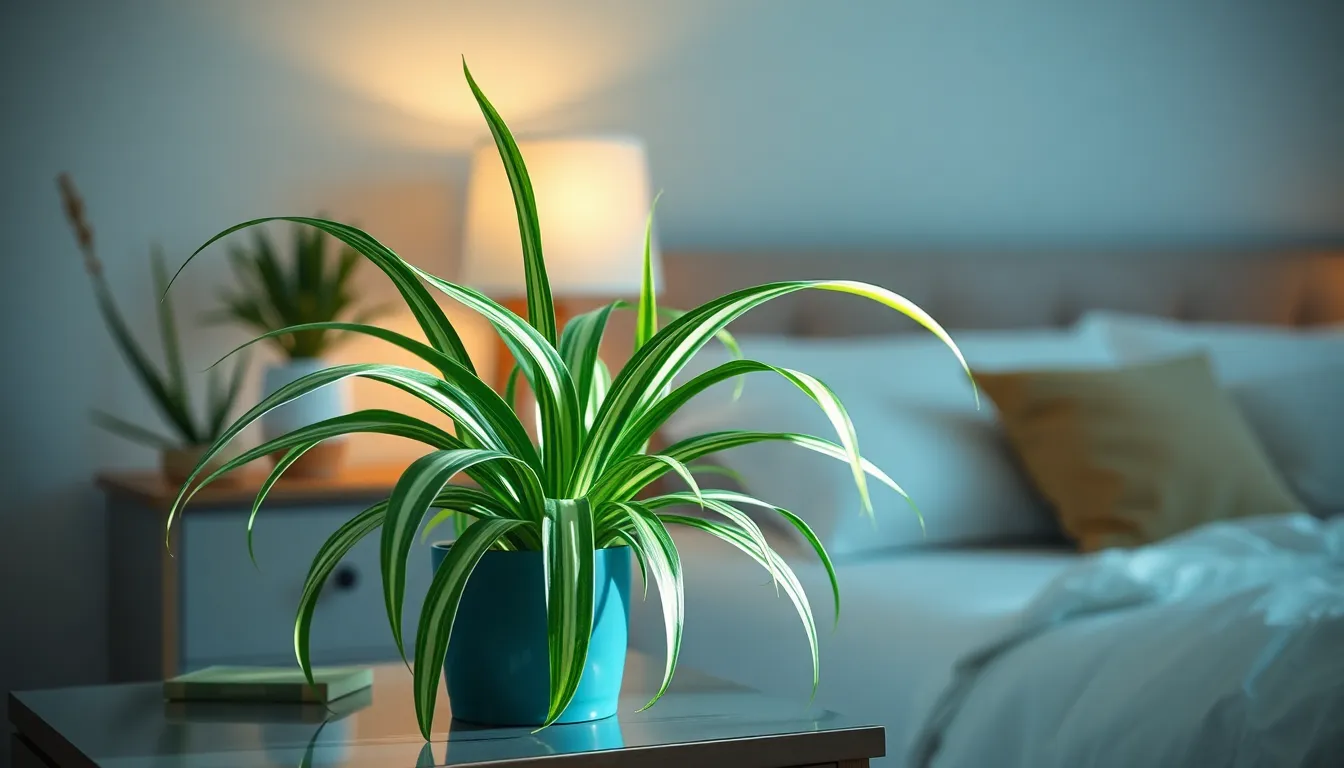
Spider plants stand out as exceptional bedroom companions that work tirelessly to enhance your sleep environment. We’ve found them to be one of the most reliable oxygen producers for nighttime air improvement.
Generates High Levels of Oxygen Throughout the Night
Spider plants produce high levels of oxygen throughout the night, making them beneficial for improving indoor air quality while you sleep. Unlike many houseplants that only photosynthesize during daylight hours, these remarkable plants continue their air purifying work around the clock. We particularly appreciate how they complement other bedroom plants like snake plants and peace lilies by adding another layer of oxygen production to your sleep sanctuary.
Their continuous oxygen generation helps maintain better air circulation in enclosed bedroom spaces. Studies show that having oxygen producing plants like spider plants can contribute to more restful sleep by ensuring cleaner air quality during your most vulnerable hours.
Produces Baby Plants for Easy Propagation
Spider plants offer prolific production of baby plants called “spiderettes” which makes propagation effortless for expanding your indoor garden. These miniature plantlets develop naturally along trailing stems, creating opportunities to multiply your bedroom greenery without purchasing additional plants. We love how you can easily snip these baby plants and root them in water or soil to create new spider plants for other rooms.
The propagation process requires minimal effort compared to other houseplants. Simply place the spiderettes in small containers of water until roots develop, then transplant them into potting soil. This natural reproduction cycle means you’ll have a continuous supply of air purifying plants to enhance multiple areas of your home.
Adapts Well to Various Light Conditions
Spider plants adapt well to various light conditions, which means they can thrive in both low light and brighter bedroom environments. Their versatility makes them suitable for bedrooms with limited natural light or those with large windows that receive abundant sunlight. We’ve observed spider plants flourishing in rooms with as little indirect light as typical bedroom settings provide.
Their tolerance for different lighting situations eliminates the guesswork of plant placement in your bedroom. Whether you position them on a nightstand away from windows or hang them near brighter areas, spider plants maintain their distinct arching green and white striped leaves. This adaptability ensures they’ll continue producing oxygen and improving your bedroom’s aesthetic appeal regardless of your room’s exact lighting conditions.
Lavender: The Natural Sleep Aid
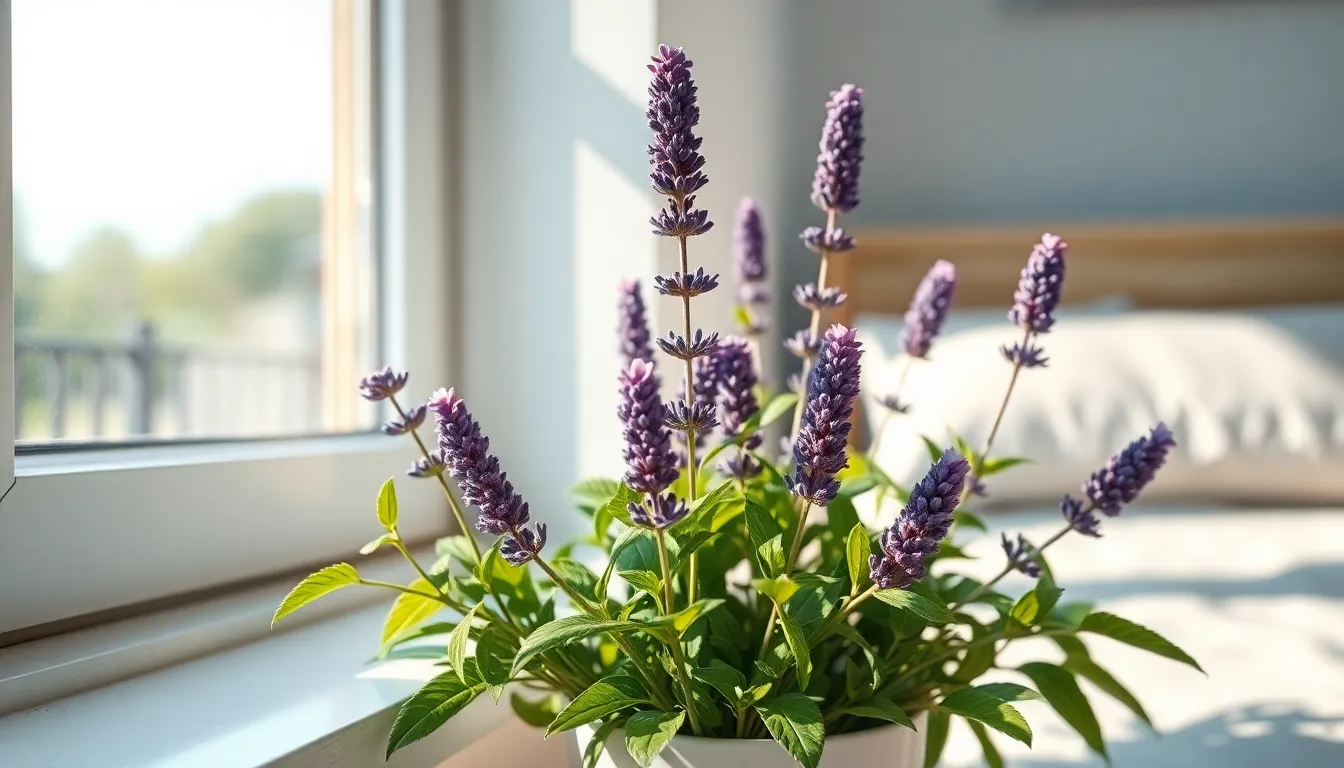
While snake plants and peace lilies excel at air purification, lavender takes a different approach by directly targeting your nervous system through its natural aromatherapy properties. This fragrant herb stands out as the ultimate bedroom plant for those seeking deeper, more restful sleep.
Promotes Relaxation with Soothing Aromatherapy
Lavender’s distinctive scent works immediately to calm your mind and prepare your body for sleep. Research shows that lavender aromatherapy naturally lowers heart rate and blood pressure, creating the ideal physiological conditions for rest. The Miami Miller School of Medicine conducted studies proving that lavender’s scent helped babies achieve deeper sleep cycles while simultaneously reducing stress levels in their mothers.
Simply placing lavender near your bedside releases its therapeutic compounds throughout the night. These natural aromatherapy molecules interact with your brain’s limbic system, triggering relaxation responses that complement the oxygen rich environment created by your other bedroom plants. The gentle fragrance provides continuous sleep enhancement without requiring any additional preparation or maintenance.
Reduces Anxiety and Stress Levels
Lavender directly addresses the mental barriers that prevent quality sleep by targeting anxiety at its source. Scientific studies demonstrate that exposure to lavender scent significantly reduces cortisol levels, the primary stress hormone that keeps you awake at night. This natural stress reduction creates a peaceful mental state that allows your body to transition smoothly into deep sleep phases.
The plant’s calming effects extend beyond bedtime, providing ongoing anxiety relief throughout your sleeping hours. Regular exposure to lavender aromatherapy helps regulate your nervous system, breaking the cycle of stress induced insomnia that affects millions of people. This makes lavender particularly valuable for individuals who struggle with racing thoughts or work related stress that interferes with their sleep quality.
Requires Bright Light and Well-Draining Soil
Lavender thrives with approximately six hours of direct sunlight daily, making a sunny bedroom windowsill the perfect location. This bright light requirement ensures the plant produces maximum levels of its therapeutic essential oils while maintaining healthy growth. Well draining soil prevents root rot and keeps your lavender producing its signature fragrance consistently.
Water your lavender sparingly, allowing the soil to dry completely between waterings to prevent moisture related problems. The plant’s Mediterranean origins make it naturally drought tolerant, requiring watering only every 2-3 weeks in most indoor environments. This low maintenance care routine makes lavender accessible for busy homeowners who want natural sleep enhancement without complex plant care requirements.
Rubber Plant: The Stylish Air Cleaner
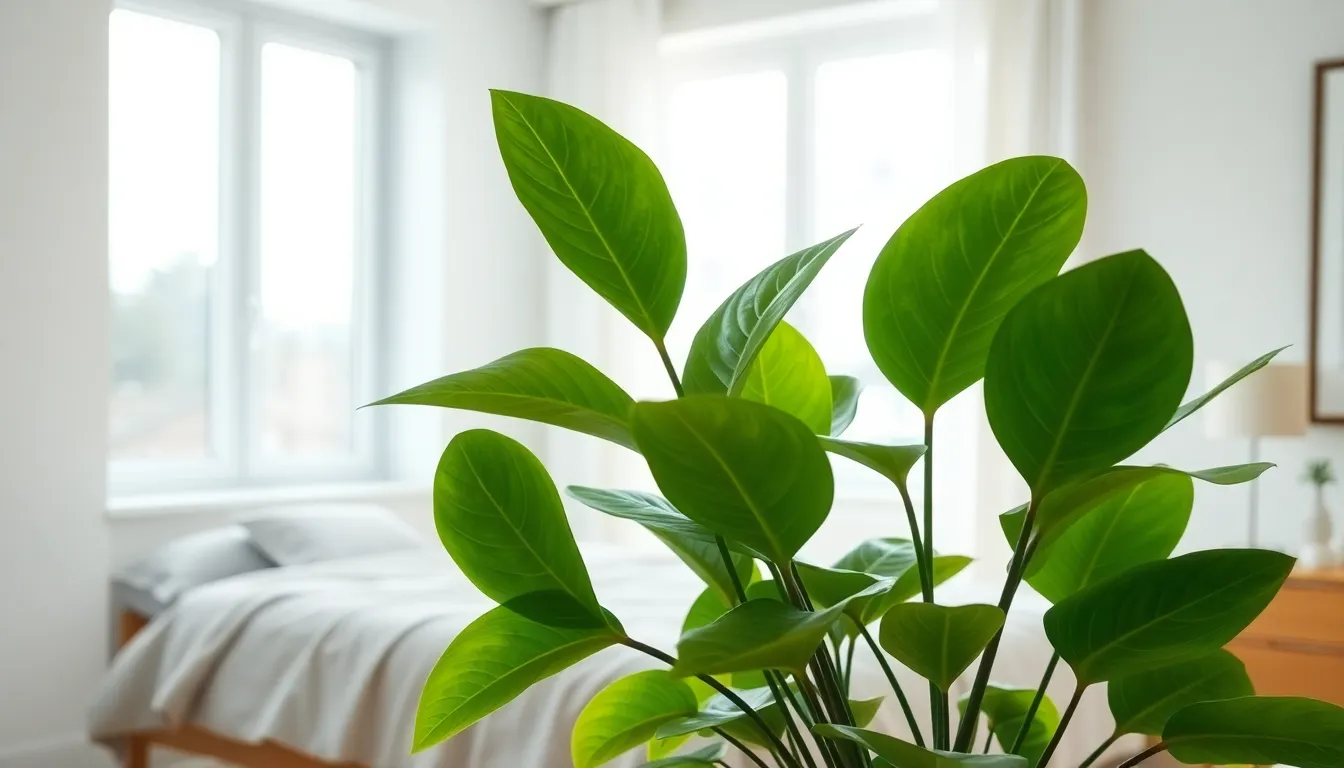
Building on our collection of bedroom air purifiers, we’re excited to introduce the Rubber Plant as another exceptional choice for creating healthier sleep environments.
Removes Formaldehyde and Other Indoor Pollutants
Rubber Plants excel at eliminating formaldehyde from bedroom air, targeting this common volatile organic compound found in many household products like furniture, carpets, and cleaning supplies. These powerful air cleaners work continuously to filter out harmful toxins that can disrupt sleep quality and overall health. We particularly appreciate how Rubber Plants complement the nighttime oxygen production of Snake Plants by focusing on daytime pollutant removal. Studies show these plants effectively process indoor air contaminants through their large leaf surface area and efficient root systems. Formaldehyde levels can decrease significantly within days of placing a mature Rubber Plant in your bedroom, creating cleaner breathing conditions alongside your existing plant collection.
Features Large, Glossy Leaves for Visual Appeal
Large, glossy leaves make Rubber Plants standout decorative elements that enhance any bedroom’s aesthetic appeal while maintaining their air purifying function. Their deep green foliage creates a sophisticated, lush appearance that complements the varied textures of Snake Plants, Peace Lilies, and Spider Plants we’ve already discussed. We love how these broad leaves reflect light beautifully, adding visual depth to bedroom spaces without overwhelming smaller plants in your collection. The waxy surface of Rubber Plant leaves stays naturally shiny with minimal maintenance, ensuring your bedroom maintains its polished look year round. Their substantial presence makes them excellent focal points for larger bedrooms or as companion plants to fill empty corners near your existing air purifying setup.
Grows Well in Medium to Bright Indirect Light
Medium to bright indirect light conditions make Rubber Plants adaptable additions to most bedroom lighting situations, thriving in environments that might be too bright for your low light loving Snake Plants. These versatile plants perform best near windows with filtered sunlight, positioning them perfectly to complement the varied light requirements of your bedroom plant collection. We find Rubber Plants particularly useful for bedrooms with east or west facing windows where morning or afternoon light provides ideal growing conditions. Their ability to tolerate different light levels means you can place them strategically throughout your bedroom without worrying about exact positioning requirements. Unlike some air purifying plants that struggle in brighter conditions, Rubber Plants actually improve their pollutant filtering efficiency with adequate light exposure.
English Ivy: The Versatile Trailing Plant
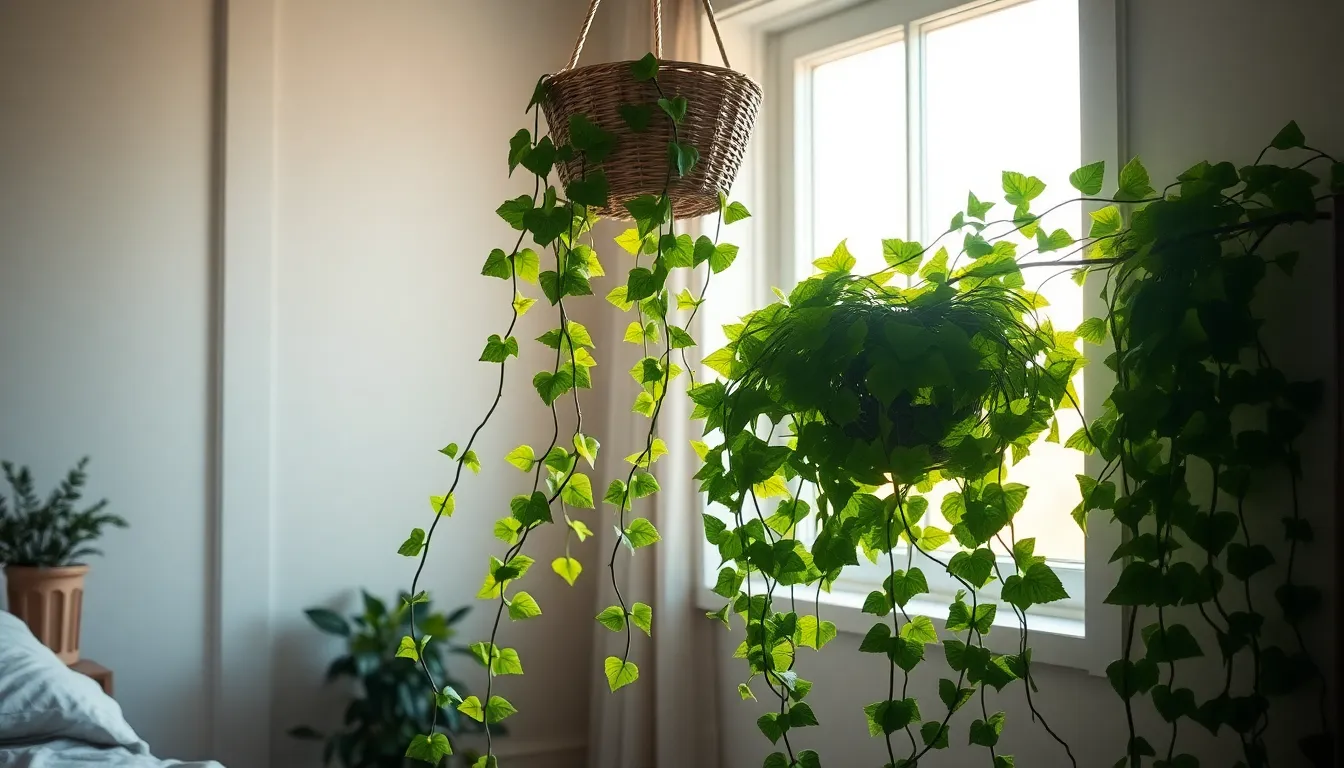
English Ivy brings unique air purification benefits and stunning decorative appeal to your bedroom sanctuary. This trailing beauty complements our previously discussed plants by targeting exact air quality issues while adding visual dimension to your space.
Reduces Airborne Mold Particles
English Ivy stands out as a natural mold fighter that improves indoor air quality for allergy sufferers. Research shows this plant actively captures and reduces airborne mold particles, creating cleaner breathing conditions while you sleep. We particularly recommend English Ivy for bedrooms with humidity issues or poor ventilation where mold spores commonly accumulate.
Placing English Ivy strategically near windows or in corners helps maximize its mold reduction capabilities. The plant’s trailing nature allows it to cover larger surface areas, increasing its effectiveness at filtering contaminated air. Your bedroom air becomes noticeably fresher as English Ivy works continuously to trap and eliminate these harmful particles.
Creates Beautiful Cascading Visual Effects
English Ivy transforms ordinary bedroom spaces with its elegant cascading growth pattern. The plant’s natural trailing habit makes it perfect for hanging baskets, elevated shelves, or climbing supports that add vertical interest to your sleep sanctuary. We love how English Ivy creates dramatic flowing effects that soften hard edges and bring natural movement to bedroom decor.
Positioning English Ivy at different heights throughout your bedroom creates layered visual appeal that complements other plants like snake plants and peace lilies. The plant’s lush green foliage provides year round beauty without the maintenance requirements of flowering plants. Your bedroom gains sophisticated natural artwork that enhances relaxation while serving functional air purification purposes.
Thrives in Cool Temperatures and Moderate Light
English Ivy adapts perfectly to typical bedroom conditions that many other plants find challenging. The plant flourishes in cooler temperatures between 65-70°F, making it ideal for bedrooms where we maintain comfortable sleeping temperatures. Cool bedroom environments that might stress tropical plants actually help English Ivy thrive and maintain its vibrant appearance.
Moderate light levels found in most bedrooms provide exactly what English Ivy needs for healthy growth. We find this plant performs well in east or north facing bedroom windows where direct sunlight won’t scorch its delicate leaves. English Ivy’s tolerance for lower light conditions makes it incredibly versatile for placement throughout your bedroom, whether on nightstands, dressers, or hanging from ceiling hooks.
Pothos: The Beginner-Friendly Air Purifier
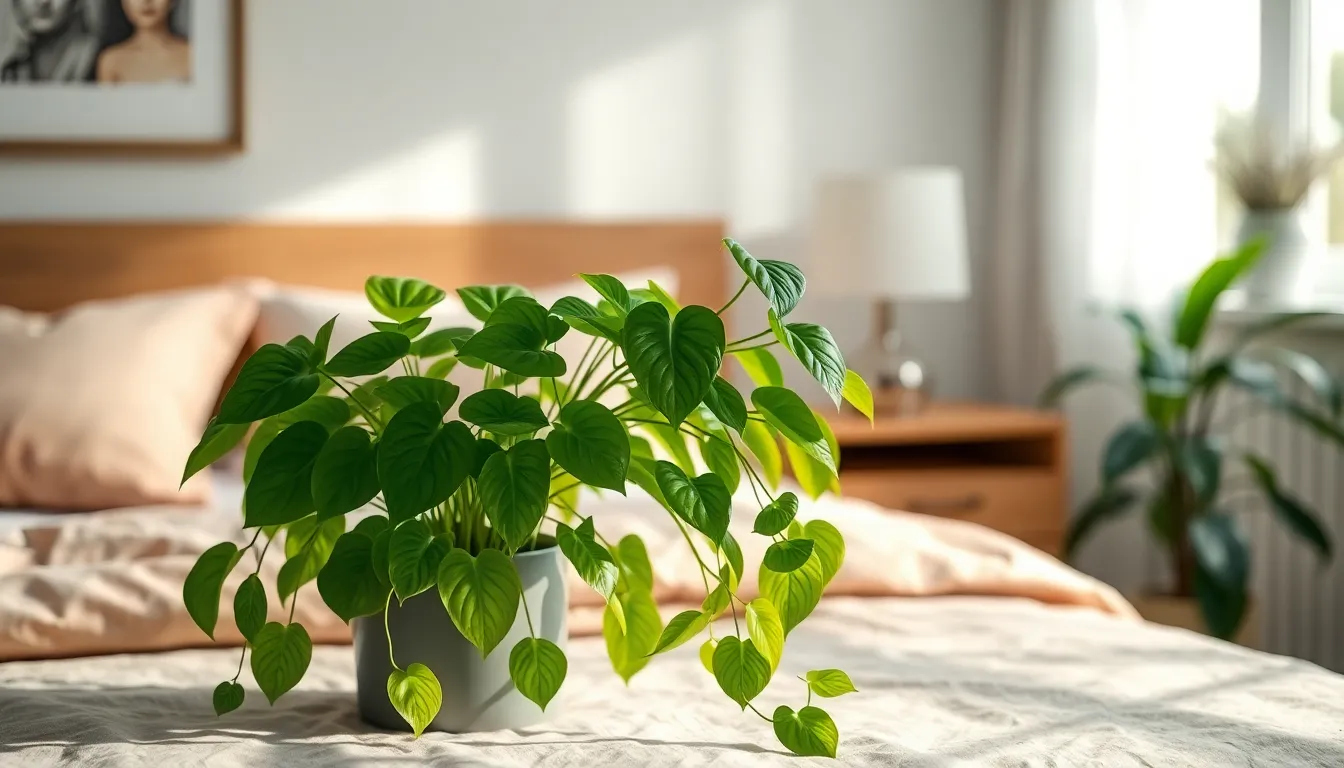
We’ve discovered that pothos stands out as the perfect entry point for creating a healthier bedroom environment. Its remarkable ability to thrive even though neglect makes it an ideal choice for those new to bedroom gardening.
Tolerates Neglect and Low Light Conditions
Pothos excels in the dimly lit conditions typical of most bedrooms. Unlike many houseplants that demand bright light and constant attention, pothos adapts seamlessly to low light environments where other plants struggle to survive. We find this particularly valuable since bedrooms often have limited natural light due to blackout curtains or north-facing windows.
Watering becomes effortless with pothos since it tolerates irregular watering schedules. Most bedroom plant enthusiasts can water their pothos every 1-2 weeks without worry, making it perfect for busy lifestyles or frequent travelers. The plant’s resilience means it won’t suffer from occasional neglect, unlike more demanding species that require daily monitoring.
Temperature fluctuations that occur in bedrooms don’t phase pothos plants. They adapt well to the cooler nighttime temperatures and warmer daytime conditions that characterize most sleeping spaces, maintaining their health and appearance regardless of climate control variations.
Removes Common Indoor Air Pollutants
Pothos works continuously to filter harmful toxins from bedroom air throughout both day and night cycles. Research shows that pothos effectively removes formaldehyde, benzene, and xylene from indoor environments, creating cleaner air for better sleep quality. These pollutants commonly enter bedrooms through furniture, carpets, and household cleaning products.
Air purification happens through the plant’s extensive root system and broad leaves. We’ve found that a single mature pothos can process toxins from spaces up to 100 square feet, making it suitable for most bedroom sizes. The plant’s natural filtration system works around the clock, continuously improving air quality while you sleep.
Indoor air quality improvements become noticeable within days of adding pothos to your bedroom. Studies indicate that pothos can reduce indoor air pollutant levels by up to 70% within the first week of placement, contributing to the overall air purification network alongside other bedroom plants.
Grows Quickly with Trailing or Climbing Habits
Pothos demonstrates fast growth that provides immediate visual impact in bedroom spaces. New growth appears within weeks of proper placement, with vines extending several inches monthly under optimal conditions. This rapid development means you’ll see results quickly compared to slower-growing bedroom plants.
Trailing growth patterns offer versatile decorative options for bedroom placement. We recommend positioning pothos on nightstands, dressers, or hanging planters where its cascading vines can create natural green curtains. The trailing habit also allows the plant to spread its air-purifying benefits across a wider area of your bedroom.
Climbing capabilities enable creative vertical displays when provided with support structures. Pothos can grow up moss poles, trellises, or even along bedroom walls, maximizing the plant’s footprint without consuming valuable floor space. This adaptability makes pothos suitable for bedrooms of any size, from compact apartments to spacious master suites.
Conclusion
Creating a healthier bedroom environment doesn’t require major renovations – just the right selection of plants. We’ve explored how each of these green companions brings unique benefits to your sleep sanctuary while working together to maximize air quality and comfort.
The beauty of these bedroom plants lies in their low-maintenance nature and proven effectiveness. Whether you’re drawn to the night-time oxygen production of snake plants or the calming aromatherapy of lavender these options adapt to your lifestyle and space constraints.
Start with one or two plants that appeal to you most then gradually expand your collection. Your lungs will thank you for the cleaner air your stress levels will appreciate the natural beauty and your sleep quality will improve as you breathe easier throughout the night.
Frequently Asked Questions
What are the best plants for improving bedroom air quality?
The best bedroom plants for air purification include snake plants, peace lilies, aloe vera, spider plants, rubber plants, English ivy, and pothos. These plants effectively remove toxins like formaldehyde, benzene, and xylene while producing oxygen at night. They’re specifically chosen for their ability to thrive in low-light conditions and improve sleep quality.
How do snake plants help with better sleep?
Snake plants produce oxygen at night through CAM photosynthesis, unlike most plants that only photosynthesize during the day. They remove up to 87% of harmful toxins like formaldehyde and xylene within 24 hours. Place one medium-sized snake plant per 100 square feet of bedroom space for optimal air purification benefits.
Can peace lilies really increase humidity in the bedroom?
Yes, peace lilies act as natural humidifiers through their transpiration process. A single mature peace lily can raise humidity levels by 5-10%, creating more comfortable breathing conditions during sleep. This is especially beneficial for people who wake up with dry throats or experience nighttime congestion.
Which bedroom plants require the least maintenance?
Snake plants, aloe vera, and pothos are the most low-maintenance options. They only need watering every 2-3 weeks, thrive in low light conditions, and can tolerate neglect. These plants are perfect for busy homeowners who want air purification benefits without intensive plant care requirements.
Does lavender actually help you sleep better?
Yes, lavender’s natural aromatherapy properties promote relaxation by lowering heart rate and blood pressure. Studies show that lavender can improve sleep quality and reduce stress levels, making it particularly beneficial for people with insomnia. Its soothing scent creates ideal conditions for restful sleep.
How many plants should I put in my bedroom?
For optimal air purification, use one medium-sized plant per 100 square feet of bedroom space. You can combine different plants for maximum benefits – for example, pairing a snake plant for nighttime oxygen production with a peace lily for humidity control creates a comprehensive air-improving system.

